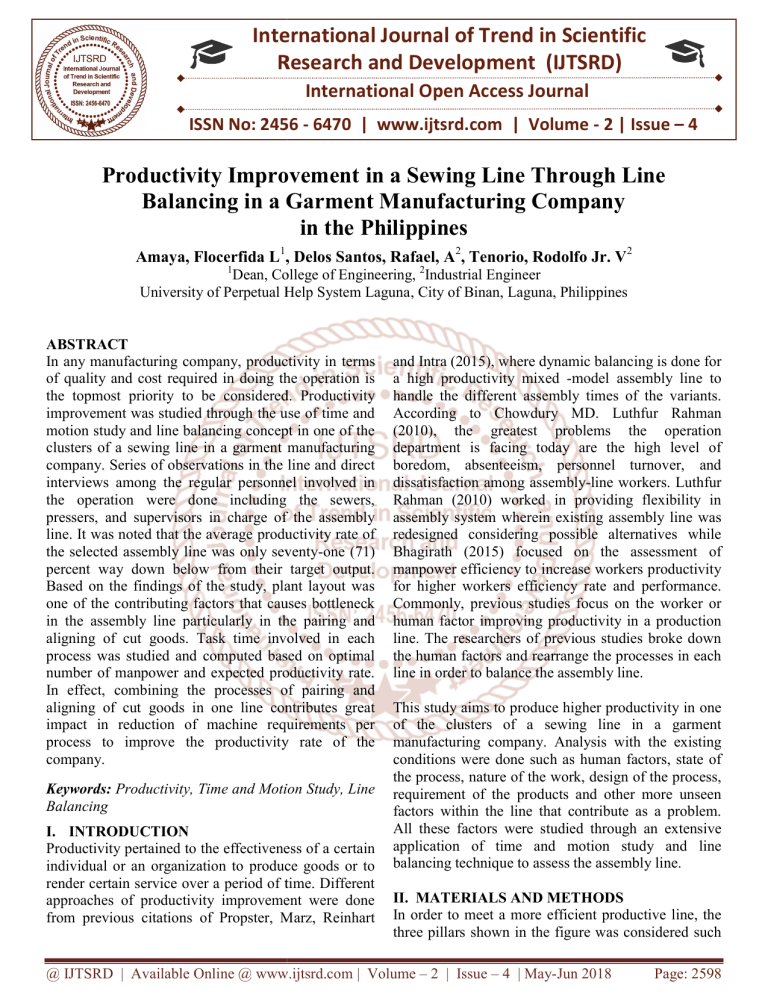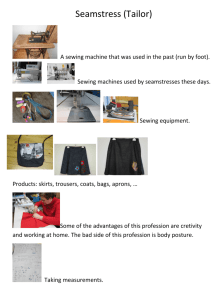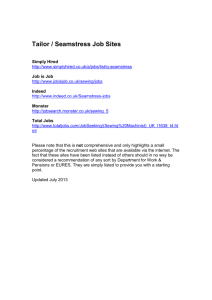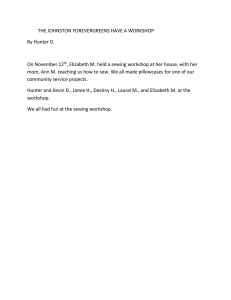
International Journal of Trend in Scientific
Research and Development (IJTSRD)
International Open Access Journal
ISSN No: 2456 - 6470 | www.ijtsrd.com | Volume - 2 | Issue – 4
Productivity Improvement in a Sewing Line Through
hrough Line
Balancing in a Garment Manufacturing Company
in the Philippines
Amaya, Flocerfida L1, Delos Santos, Rafael, A2, Tenorio, Rodolfo Jr. V2
1
Dean, College of Engineering, 2Industrial Engineer
University of Perpetual Help System Laguna
Laguna, City of Binan, Laguna, Philippines
ABSTRACT
In any manufacturing company, productivity in terms
of quality and cost required in doing the operation is
the topmost priority to be considered. Productivity
improvement was studied through the use of time and
motion study and line balancing concept in one of the
clusters of a sewing line in a garmentt manufacturing
company. Series of observations in the line and direct
interviews among the regular personnel involved in
the operation were done including the sewers,
pressers, and supervisors in charge of the assembly
line. It was noted that the average productivity rate of
the selected assembly line was only seventy
seventy-one (71)
percent way down below from their target output.
Based on the findings of the study, plant layout was
one of the contributing factors that causes bottleneck
in the assembly line particularly
icularly in the pairing and
aligning of cut goods. Task time involved in each
process was studied and computed based on optimal
number of manpower and expected productivity rate.
In effect, combining the processes of pairing and
aligning of cut goods in onee line contributes great
impact in reduction of machine requirements per
process to improve the productivity rate of the
company.
Keywords: Productivity, Time and Motion Study, Line
Balancing
I. INTRODUCTION
Productivity pertained to the effectiveness of a ce
certain
individual or an organization to produce goods or to
render certain service over a period of time. Different
approaches of productivity improvement were done
from previous citations of Propster, Marz, Reinhart
and Intra (2015), where dynamic balancing
balanc
is done for
a high productivity mixed -model
model assembly line to
handle the different assembly times of the variants.
According to Chowdury MD. Luthfur Rahman
(2010), the greatest problems the operation
department is facing today are the high level of
boredom,
edom, absenteeism, personnel turnover, and
dissatisfaction among assembly-line
assembly
workers. Luthfur
Rahman (2010) worked in providing flexibility in
assembly system wherein existing assembly line was
redesigned considering possible alternatives while
Bhagirath (2015) focused on the assessment of
manpower efficiency to increase workers productivity
for higher workers efficiency rate and performance.
Commonly, previous studies focus on the worker or
human factor improving productivity in a production
line. The researchers
searchers of previous studies broke down
the human factors and rearrange the processes in each
line in order to balance the assembly line.
This study aims to produce higher productivity in one
of the clusters of a sewing line in a garment
manufacturing company.
mpany. Analysis with the existing
conditions were done such as human factors, state of
the process, nature of the work, design of the process,
requirement of the products and other more unseen
factors within the line that contribute as a problem.
All these factors were studied through an extensive
application of time and motion study and line
balancing technique to assess the assembly line.
II. MATERIALS AND METHODS
In order to meet a more efficient productive line, the
three pillars shown in the figure was considered such
@ IJTSRD | Available Online @ www.ijtsrd.com | Volume – 2 | Issue – 4 | May-Jun
Jun 2018
Page: 2598
International Journal of Trend in Scientific Research and Development (IJTSRD) ISSN: 2456-6470
as improving the cycle time, balance the line, and
allocate optimal headcount to increase profitability of
the company.
Figure1. Conceptual Framework of the study
This study uses descriptive method of research
wherein data were gathered through actual
observations and interview questionnaires regarding
the operations within the assembly line were
administered to the operators of the line including the
Line Leader, Supervisors, Production Engineers and
Manager. Furthermore, the following tools were used
as instrumentation of the study: Fishbone diagram to
deeply analyze the root causes of the problems and
relationships on how they contribute in affecting the
assembly line; Pareto Diagram to graphically
understand the occurrence of problems in each
processes by ranking them into the most frequent and
in order to find out which is the most contributing
factor to problem within the sewing line; Time and
Motion study to measure and record the existing cycle
time of the operation and analyze the deficiencies in
the existing cycle time of the operation and compute
and set alternative standard time for the line; and
Work Sampling Method to determine the amount of
work, and delay, through work observation at random
time.
III. DISCUSSION AND RESULTS
For three (3) months of observation, some factors that
affect the productivity of a sewing line were noted
such as manpower, material or product, process and
method of operation. Historical data of the previous
weeks of operation of the line regarding their output
per regular eight working hours per day were also
looked into. Variation of garments being processed in
the line was also considered as basis of assessing the
present operation of the line. The results of time study
done was assessed based on the current standards and
actual observations in the line.
Current set up of one of the cluster in a sewing line of
the garment company in terms of distance and
transportation time between operations was shown in
the table below.
Table1. Actual distance and time consumed in a line
Current
Average
NVA’s per
Movement Description
Distance Observed
Operation
(Meter) Time (sec)
Going to Cut Goods Storage
17.969
1
Getting& searching for Cut Goods
4.82
112.805
Going back to the Table
17.848
Going to Cut Goods Storage
17.361
2
Getting & searching for Cut Goods
4.82
99.497
Going back to the Table
16.39
Going to Operator 5
12.882
3
Getting Supply
5.115
4.501
Going back to the machine
11578
Total Time
Consumed
(sec)
148.62
113.25
28.961
@ IJTSRD | Available Online @ www.ijtsrd.com | Volume – 2 | Issue – 4 | May-Jun 2018
Page: 2599
International Journal of Trend in Scientific Research and Development (IJTSRD) ISSN: 2456-6470
Table 2: Current Task Time of Operation in a Sewing Line
Process Description
Task Time (Min)
Press fuse back neck + Shoulder x2
0.476
Press fuse at sleeve Arm x2
1.155
Join Shoulder x2
0.404
Attach Sleeve at Arm Hole x2
1.144
Close Sleeves & sides x2
1.105
1" Fold Bottom x1
0.784
1" Fold Sleeve Opening Arm x2
0.683
Attach Piping to bottom front Center x2
0.601
Basting + Insert Piping End at Bottom x2
0.667
Bend back Piping Bottom front Center x2
0.758
Attach front-neck Piping cont. x1
0.672
Make Label
0.189
Attach main label to back neckline
0.497
Basting + Insert Piping End at front neck x2
0.667
Bend back front-neck Piping cont x1
0.918
Stitch lock Bend back End 4x
0.417
Attach Side Label
0.436
TOTAL TIME
11.573
The table above showed the current task time of each process in one of the clusters of sewing line of which was
11.573 minutes per garment, and currently used as the basis of computing the target output and productivity
level of the line. The standard time of operation was measured plus the allowance factor of Twenty percent
(20%) which was set by the GSD (General Sewing Development) Department.
Process no.
1
2
3
4
5
6
7
8
9
10
11
12
13
14
15
16
17
Table 3: Current Task Time of Operation & Average Time of Ten Trials of Observation of Time Study
Time study: Task
Process no.
Process Description
Task Time (Min)
Time (Min)
1
Press fuse back neck + Shoulder x2
0.476
0.46
2
Press fuse at sleeve Arm x2
1.155
0.29
3
Join Shoulder x2
0.404
0.87
4
Attach Sleeve at Arm Hole x2
1.144
1.14
5
Close Sleeves & sides x2
1.105
1.96
6
1" Fold Bottom x1
0.784
1.33
7
1" Fold Sleeve Opening Arm x2
0.683
1.12
8
Attach Piping to bottom front Center x2
0.601
0.59
9
Basting + Insert Piping End at Bottom x2
0.667
0.64
10
Bend back Piping Bottom front Center x2
0.758
0.67
11
Attach front-neck Piping cont. x1
0.672
0.93
12
Make Label
0.189
0.70
13
Attach main label to back neckline
0.497
0.23
14
Basting + Insert Piping End at front neck x2
0.667
0.62
15
Bend back front-neck Piping cont x1
0.918
0.85
16
Stitch lock Bend back End 4x
0.417
0.91
17
Attach Side Label
0.436
0.42
TOTAL TIME
11.573
13.91
According to the result of the ten (10) trials f observation of time study, it was found out that the currentn or
existing task time of operation of a Sewing Line whichh was 11.573 minutes did not match the observed time
of 13.91 minutes. The current and existing task time of operation of a sewing Line was not updated and did not
fit to the actual processing time of operation in the line.
@ IJTSRD | Available Online @ www.ijtsrd.com | Volume – 2 | Issue – 4 | May-Jun 2018
Page: 2600
International Journal of Trend in Scientific Research and Development (IJTSRD) ISSN: 2456-6470
per day was four hundred ninety-nine (499) units
wherein an average of five (5) hours overtime per day
was allocated in order to meet the desired output and
an average of seventeen units (17) units per hour were
lost due to inefficiency of the line.
Figure 2: Productivity Rate per Week of a Sewing
Line
Figure 2 showed the inconsistency of productivity
level of a Sewing Line which productivity level
averages to only seventy-one percent (71%) and the
highest productivity rate of the line per week was
eighty percent (80) as reflected in the output per day
which was the set target output of four hundred thirtyfive (435) units per day. The average output produced
Figure 3: Bottleneck Operation of a Sewing Line
Figure 3 showed the time per process, the longest
processing time of the line which was in operation 5
(close sleeves and sides) and the shortest was process
13 (attach main label to back neckline).
Figure4. Factors Affecting Bottleneck
Figure 4 showed the factors contributing to bottleneck
based on the observation and interview conducted by
the researchers in the line. Under this method, longer
time of processing was rooted to the longer time of
preparation of parts of the garment which was
considered as non-value adding activity. For material,
re-measuring due to missing meto-size stickers, recutting due to wrong measurement of the cut-goods
and rework due to defective stitches was observed.
For machine, unexpected machine problem or
breakdown was observed. There was no problem in
manpower because all operators were regular workers
and been working for almost ten (10) to twenty (20)
years in the company which meant that they were
already professional sewers and pressers. The factor
over environment was disregarded since the facility
was sufficiently ventilated and supplied with enough
lighting.
@ IJTSRD | Available Online @ www.ijtsrd.com | Volume – 2 | Issue – 4 | May-Jun 2018
Page: 2601
International Journal of Trend in Scientific Research and Development (IJTSRD) ISSN: 2456-6470
Using work sampling technique for 5 days
observation, it was identified that the most frequently
occurring problem in the line among all the observed
factors causing bottleneck in a sewing line was the
time of preparation of cut goods such as pairing and
aligning of parts during sewing operations which
averages to 126 times per day and averagely
consumes 44.09 minutes per day.
Figure 5: Occurrence of Factors Causing Bottleneck
Using Pareto Analysis, it was identified that the most
contributing factor that caused bottleneck was the
longer time of preparation of cut goods supply in the
line.
IV. CONCLUSIONS AND
RECOMMENDATIONS
Based on the findings of the study, it can be
concluded that the current standard time used in the
Sewing Line was not updated and did not fit the
current processing time of the line base on the 10 trial
time study observation. An improper line layout of the
line was not appropriate for cut goods storage, sewing
machines and pressing machines due to distance
travelled caused travel distance and improper process
flow. Longer process time in pairing and aligning of
cut goods was the most conttributing factor that
causes bottleneck which did not add value to the
operation.
Also, since the normal time of operation of the line
was outdated according to time study results, it would
be better to update it to new standard time where
proper setting of target output would be obtained.
After assessing the possible alternatives in treating the
root cause of bottleneck of the line which was the
longer time of preparation such as pairing and
aligning of the cut goods, it can be concluded that one
possible solution was to combine processes that have
same machine requirements in order to reduce the
preparatory time of pairing and aligning. Since
balancing of the line through distribution of workload
in each process was impossible due to different
machine requirements per process, right manpower
alignment and distribution would balance the
operation of the line.
Updated standard time of operation in a Sewing Line
gave it a proper baseline of computing for the target
output. The existing twenty (21) operators could also
be reduced into optimal eighteen (18) workers. Also,
combination of process 4 and 5 was effective in
reducing the time consumed by pairing and aligning
parts of garments which was considered as non-value
adding activity of the process, thus making the
combined process more productive than the
uncombined process. The new layout of the Sewing
Line, where cut goods storage sewing machines and
pressing machines were rearranged according to
process sequence made the processing and product
flow more smooth, thus helped eliminate and reduce
travel distance consuming time. The current standard
time and the proposed standard time of operation set
in a Sewing Line was significantly different, thus the
proposed standard time helped set a proper baseline in
measuring the target output for the line and set
optimal manpower allocation for the line to meet
higher productivity.
For the next phase of improvement, it is
recommended to to adopt 5’s (Sort, Standardized, Set
in order, Shine, Sustain) to properly control the flow
of materials in the line by proper sorting of cut goods
and to reduce the non-value adding activity such as
preparation of cut goods due to unorganized flow of
materials.
REFERENCES
1. Aadarsh Adeppa (2015), A Study on Basics of
Assembly Line Balancing. International Journal
on Emerging Technologies, 294-297.
https://www.google.com.ph/url?sa=t&rct=j&q=&
esrc=s&source=web&cd=1&cad=rja&uact=8&ve
d=ahUKEwiE2cbQjovXAhWBs5QKHVr_CoMQ
FggkMA&url=https%3A%2F%2Fwww.researchg
ate.net%2Ffile.OstFileLoader.html%3Fid%3D56a
3580161432504bf8b481%26assetKey%3DAS%2
53A321007137558528%2540453545473420&usg
=AOvVaw0B036OP3sOiBB4nSYcwthr
@ IJTSRD | Available Online @ www.ijtsrd.com | Volume – 2 | Issue – 4 | May-Jun 2018
Page: 2602
International Journal of Trend in Scientific Research and Development (IJTSRD) ISSN: 2456-6470
2. Aasheet Kumar1, Gaurav Chaudhary2, Manish
Kalra3, & Binit Kumar Jha (2014). Optimization
Of Cycle Time For Wire Harness Assembly –
Line Balancing And Kaizen Approach.
International Journal of Innovative Research in
Science, Engineering and Technology, 3(8), 1-8.
https://www.ijirset.com/upload/2014/august/36_O
ptmization.pdf
3. Abdul Talib Bon & Daiyanni Daim (2010). Time
Motion Study In Determination Of Time Standard
In Manpower Process. 3rd Engineering
Conference on Advancement in Mechanical and
Manufacturing for Sustainable Environment, 1-6.
https://core.ac.uk /download/pdf/12008172.pdf
4. Balaji Rathod, Prasad Shinde, Darshan Raut,
Govind
Waghmare (May 2016). Optimization of Cycle
Time by Lean Manufacturing Techniques-Line
Balancing Approach. International Research in
Applied Science & Engineering Technology, 4(5),
224226.http://www.ijraset.com/fileserve.php?FID=46
30
5. Chowdury M.D. & Luthfur Rahman (2010). ReBalancing of Generalize Assembly Line –
Searching Optimal Solution for SALBP. Industrial
Engineering and Operation Management Journal,
548-553.
http://www.ieomsociety.org/paper/252%20Luthful
.pdf
6. D. Roy & D. Khan (December2008). Assembly
LineBalancing to Minimize Balancing Loss an
System Loss. 6(11), 15.
http://www.iaujournals.ir/article_511022_a2ba368
003a70efca7951de4b512f0b.pdf
7. Fatemeh Mohebalizadehgashti (2016). Balancing,\
Sequencing and Determining the Number and
Length of Workstations in a Mixed Model
Assembly Line. A Thesis presented to The
University
of
Guelph,1134.https://atrium.lib.uoguelph.ca/xmlui/
bitstream/handle/10214//Mohebalizadehgashti_Fat
emeh_201605_Msc.pdf?sequence=1
8. F.Mercan (2012). Balancing Mixed Model
Assembly Lines in an Automotive Supplier by
Reconfiguring Layout. Thesis for Graduate School
of Natural and Applied Sciences of Dokuz Eylul
University,
199.http://www.fbe.deu.edu.tr/ALL_FILES/Tez_
Arsvi/2012/yl_t3073.pdf
9. Gantner, Karl (2016). Production Leveling and
Cycle Time Reduction in Satellite Manufacturing.
Leaders for Global Operations Program at MIT,
5052.https://dspace.mit.edu/handle/1721.1/104217
10. M. Guner, O. Yucel and C. Unal (2012).
Applicability of Different Line Balancing Method
in the Production of Apparel. pp 7784.http://dergipark.gov.tr/download/articlefile/22000
11. Mihir R. Prajapati & Vivek A. Deshpande (2015).
Cycle Time Reduction Using Lean Principles and
Techniques. International Journal of Advance
Industrial
Engineering,
3(4),
208213.http://inpressco.com/wpcontent/uploads/2015/
12/Paper2208-213.pdf
12. Naveen Kumar & Dalgobind Mahto (2013).
Assembly Line Balancing: A Review of
Developments and Trends in Approach to
Industrial Application. Global Journal of
Researches in Engineering, 13(2.1), 123.https://globaljournals.org/GJRE_Volume13/4Assembly-Line-Balancing-A-Review-of.pdf
13. Neda Manavizadeh (2013). A Simulated
Annealing Algorithm for a Mixed Model
Assembly U- Line Balancing Type-I Problem
Considering Human Efficiency and Just-In-Time
Approach. Computers and Industrial Engineering
Journal, 64(2), @ IJTSRD | Available Online @
www.ijtsrd.com | Volume – 1 | Issue – 5 | August
2017
Page:
6
669685.http://www.sciencedirect.com/science/article
/pii/SO360835212002884
14. Pranavi Yerasi (August 2011). Productivity
Improvement of a Manual Assembly Line. Office
of Graduate Studies of Texas A&M
University,61.http://oaktrust.library.tamu.ed/bitstr
eam/handle/1969.1/ETD-TAMU-2011-0810133/YERASI-THESIS.pdf?sequence=2
15. Puteri, Yuniaristanto, Hisjam (2017). Optimal
Manpower Allocation
in
Aircraft
Line
Maintenance (Case in GMF Aeroasia). AIP
Conference
Proceedings
1902,
1902(1).
http://aip.scitation.org/doi/abs/10.1063/1.5010625
?ai=1gvoi&mi=3ricys&af=R&
@ IJTSRD | Available Online @ www.ijtsrd.com | Volume – 2 | Issue – 4 | May-Jun 2018
Page: 2603
International Journal of Trend in Scientific Research and Development (IJTSRD) ISSN: 2456-6470
16. R. Bhagirath (2015). Rationalization of Manpower
in Cutting Section. Dissertation for Bachelor of
Fashion
Technology,
1-56.
http://14.139.111.26/jspui/bitstream/1/111/1/Ratio
nalization%20of%20Manpower%20in%20Cutting
%20Section%20%20%20.pdf
17. Raj, Matthew, Jose, & Sivan (2016). Optimization
Of Cycle Time in an Assembly Line Balancing
Problem. Global Colloquium in Recent
Advancement and Effectual Researches in
Engineering, Science and Technology, 25, 11461153.http://www.sciencedirect.com/science/article
/pii/S2212017316305850
18. Ranjith Raja (2015). Assembly Line Design And
Balancing. Master of Science Thesis in the
Master’s programme Production Engineering,143.
http://publications.lib.chalmers.se/records/fulltext/
220682/220682.pdf
19. Sarah Wallach (2016). The Headcount Planning
Countdown
to
Success.
http://www.peoplefluent.com/blog/headcountplanningstrategies-tactics
20. Subhash C Sarin (2016). A Survey of the
Assembly LineBalancing Procedures. Production
Planning
&
Control,
9(5),
414
434.
https://www.researchgate.net/publication/2381677
75_A_survey_of_the_assembly_line_balancing_p
rocedures
21. Stockholm, Dencker, & Hansson (2011).
Strategies forAssembly Line Re-Balancing with
Focus on Level ofAutomation. Department of
Production Engineering andManagement School
of Industrial Engineering and Management, 196.http://www.ngps.se/documents/ELUX3_Abhir
am_REDDAMEmre_OZUGUREL_THESIS.final
%20report.pdf
22. Subodh Patil Shriram Sane, Varsha Karandikar, &
Rahul Pulkurte (June 2014), Assembly Line
Balancing:A
Case
Study
in
Silencer
Manufacturing. InternationalJournal of Current
Engineering and Technology.Vol.4, No.3.
http://inpressco.com/wpcontent/Uploads/2014/05/Paper731583-1586.pdf
23. T. Borregueroa, F. Masa , JL. Menéndeza, &
M.A.Barreda (2015) , Enhanced Assembly Line
Balancing and Scheduling Methodology for the
Aeronautical Industry. The Manufacturing
Engineering Society International Conference,
990997.https://core.ac.uk/download/pdf/81111351.pdf
24. Trujillo and Bertilisson (2016). Investigation of
the Workforce Effect on an Assembly Line Using
Multi-Objective Optimization. Bachelor’s Degree
Project in Automation Engineering Bachelor
Level,
193.http://www.divaportal.se/smash/get/diva2:1049
466/FULLTEXT01.pdf
25. Tom Pape (2015). Heuristics and Lower Bounds
for theSimple Assembly Line Balancing Problem
Type 1:Overview, Computational Tests and
Improvements. European Journal of Operational
Research,240(1),
32-42.
http://www.sciencedirect.com/science/article/pii/S
0377221714005268
26. Yi-Jhen Lin, Chun-Ju Lin, & Tiffany Y. Chen
(2014), Assembly Line Balancing Problem of
Sewing Lines in Garment Industry. International
Conference on Industrial Engineering and
Operations
Management,
1215-1225
http://ieomsociety.org/ieom2014/pdfs/273.pdf
27. Yana Myronenko
Measurement
(2012).
Productivity
–
and Improvement. Department of Real Estate and
Construction
Management,
149,
5-25.
http://www.divaportal.org/smash/get/diva2:55158
1/fulltext01.pdf
@ IJTSRD | Available Online @ www.ijtsrd.com | Volume – 2 | Issue – 4 | May-Jun 2018
Page: 2604



